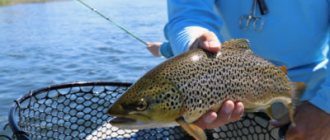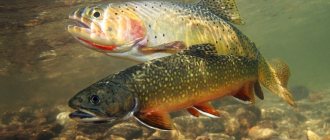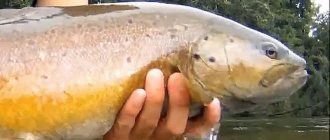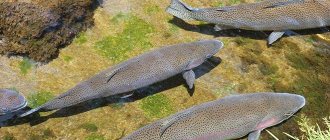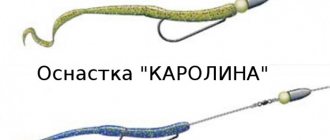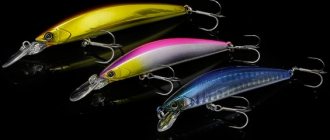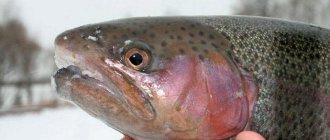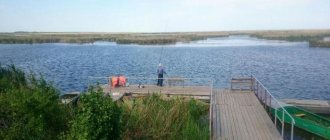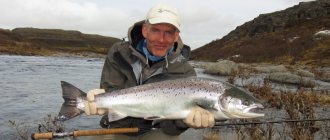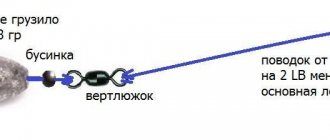About trout
Trout belongs to the salmon family and has a second name - brown trout. There are three types of trout - migratory, lake and river. The last two species, lake and river trout, are called trout.
In nature, you can find trout of various sizes, depending on habitat conditions. The average size of trout ranges from 35 cm, but in large lakes its length can reach 1 m and weigh 8 kg or more. This fish can live at least 20 years, but some specimens survive to this age.
It is very interesting to know that each type of trout is interchangeable and the division into similar species is very arbitrary. The fact is that if a lake trout is moved to a river, it will become a river trout or migratory trout and vice versa.
Features of winter fishing
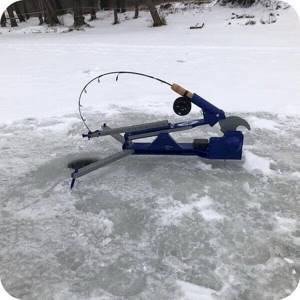
Often, platoons are equipped so that they do not freeze in winter; in this case, fishing continues all year round with the usual gear for fishing in open water. If a lake or pond is covered with ice, then appropriate gear will be required. In winter, trout are caught on the platform:
- For jig tackle, this will require a light fishing rod with a foam handle, 15-20 m of fishing line with a diameter of 0.1-0.14 mm , a nod to determine the bite selected for the jig, and the jig itself. Trout respond best to bait in the form of small bugs, ants and other living creatures.
- While trolling will be successful, this method will require stronger tackle. A fishing rod is chosen with a hard whip, a fishing line is selected that is at least 0.16 mm in diameter , a nod is also needed to determine the bite, and you can’t do without a spinner. For trout, small vertical models are chosen, and different colors are used.
- The trout also like the balancer; the tackle is standard, just like for a spinner. With this fishing method, it is important to be able to play the bait correctly so that it can attract cautious fish.
- Separately, it is worth highlighting the girders; this method is classified as passive. For equipment you will need a fishing line 0.3 mm in diameter, 10-15 m for each unit. The sinker, its weight is selected depending on the fishing conditions, the triple or double hook and the live bait itself. Girders are installed in places where trout accumulate on the platform during wintering and on relative shallows during thaws.
It is also possible to fish with float tackle in winter, with a worm serving as bait and the tackle being collected using small winter fishing rods.
Trout fishing gear
Since trout can be found in lakes and rivers, it is possible to use any gear, depending on the fishing location. The main gear is considered:
- spinning
- regular fishing rod (float)
- fly fishing

All three types of tackle can do the job perfectly. Every trout fisherman has his own gear that he is used to and can handle well. All three tackles are good, but among them there is the simplest and the most complex. The simplest gear is a float rod, and the most complex is fly fishing, the use of which requires special skills. Well, spinning is something in between, although it requires certain skills, but spinning is much easier to master than fly fishing. Each tackle involves the use of a certain type of bait.
Trout fishing gear
Trout fishing is provided by a set of gear made from universal tools and materials available to the fisherman at each fishing retail outlet. Only when assembling fly fishing gear can some difficulties arise, requiring narrow specific knowledge regarding both the rods themselves and the composition of the cords. In further information, the angler will be presented with directions for choosing various gear for trout fishing, ensuring the catch of a predator in natural conditions and in the conditions of a paid pond.
Spinning
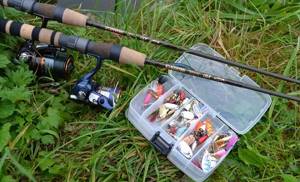
Trout fishing in the fall is most successful using spinning rods. The fish, starting to actively feed, becomes an energetic and sharp predator with aggressive behavior, sensitively responding to the placement of artificial baits in different water horizons. For fishing, spinning rods of semi-fast and fast action are selected. Ultralight tackle and tackle for supplying baits of 15–20 grams are optimal for catching predators according to their test characteristics. Since fishing can be done from boats and shorelines, spinning rod lengths vary from 1.7 to 2.3 meters when fishing from a floating craft, and for the shore, with the expectation of long-distance fishing, fishing rods with a length of 2.5 to 3.2 meters are used .
Lake trout fishing, like brook trout fishing, is universal in the selection of spinning equipment, which includes spinning reels with a high gear ratio and braided cords of small diameters, rarely exceeding a thickness of 0.15 mm. Wary fish require delicate rigs that are not overloaded with accessories in the form of ineffective leashes and bulky fasteners that make the rigs rougher and, therefore, less attractive to predators. Spinning fishing is done using wobblers, spinners and silicone baits. In some cases, it is rational to use live fry, fish fillets and pastes specially prepared for trout fishing.
Fly fishing
Trout fishing in mountain rivers and fast streams is the domain of fly fishing equipment. For fly fishing, a lightweight prefabricated fishing rod up to 2.5 meters long is equipped with an inertial reel with a reliable braking system. The volume of the reel should allow it to accommodate the main thick cord and its working part, which is selected depending on the fishing conditions and the use of the bait in a floating or sinking version.
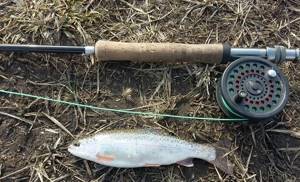
It is difficult to catch trout in winter or autumn with fly fishing, since the fish goes to the bottom horizons, where they mainly feed, but at the end of spring and throughout the summer season, especially when the mayfly emerges, this type of hunting is considered the most promising. Fly fishing is done in a wade, so as additional equipment, the angler will need to purchase waders or a floating raft, which make fishing not only more comfortable, but also much more successful in terms of choosing promising points and camouflaging the angler himself.
Important! The main lures in fly fishing are artificial dry and wet flies.
Also quite often, and it is especially effective to do this after their flight, natural insects are used.
Float rod
An effective fishing method is a float rod, or rather, a Bolognese version of this type of tackle, equipped with an inertial reel with a large drum, which allows fishing with bait swims over long distances. Telescopic fishing rods 6-7 meters long are selected from the lightest materials, graphite or carbon fiber. For fishing, a braided cord with a thickness of 0.10-0.12 mm is used at the end with a meter-long nylon leash of 0.12-0.14 mm. Hooks for trout fishing are selected based on the type of bait. Most of the selected accessories have an elongated fore-end with hook numbers from 10 to 14.
Important! They are caught with float tackle in the spring months and throughout the entire autumn season, when the predator switches to feeding in the middle water horizons.
Plant and animal baits are used as bait. Under some conditions, the predator can also be caught using wet artificial flies.
Feeder
The feeder is not as popular as all the hunting methods described above, but its effectiveness deservedly needs to be discussed during the pre-winter period, when the predator goes to the deepest points of reservoirs, which is especially important for paid ponds. For fishing, rods with a length of 2.8 -3.5 meters are used, with test parameters no higher than 50 grams. Choosing the right bait with the ability to boil and create a distinct spot of turbidity attracts predators from afar, making fishing from the bottom quite successful. The rigs are knitted from monofilament, using nylon or transparent fluorocarbon leashes one meter long in the rig, equipping the hooks with animal baits or a bright and fragrant paste.
What do you use to catch trout?
Having chosen a certain tackle, you should start choosing bait for trout. In spring and summer, trout are caught using various baits, such as worms, insects, corn, etc., but closer to autumn, their predator instinct awakens, so during this period the use of a spinning rod is more justified, since they are caught on most artificial baits .
If trout are caught using a float rod, you can use the following baits:
- muckworm;
- earthworm;
- insect larvae, bloodworms or maggots;
- live bait or dead fish;
- Red caviar;
- corn;
- cheese;
- flies.

All of them have proven themselves to be excellent when fishing for trout with a regular fishing rod. Trout is actively caught using red caviar , although this is a very expensive bait and not everyone can afford such luxury.
Trout also take well on a worm , but a dung worm, as it has a brighter reddish tint. To catch small specimens, you can get by with a piece of a worm, but if large specimens are biting, then you cannot do with just one worm. As a rule, in such cases, several worms cling to the hook in the form of a garland. The fact is that large trout are unlikely to bite on a piece of worm.
Trout is a cautious fish, so the bait should be set so that the hook does not show, otherwise the trout may not bite.
As for fish or live bait , you should not hide the hook here, as it will be difficult to hook the fish. The fish is hooked by the fin or lip. It is also possible that one hook clings to the lip, and the second to the tail. Moreover, the hooks should be at different levels. When the hook protrudes from the fish's body, the trout may confuse it with the sharp fin of the fish.
Live bait should be located in the water column or closer to the bottom. When fishing on a river, live bait is released with the flow towards the whirlpool, where the trout like to be. To provoke a bite, you can play along with the tip of the rod.
When fishing on a lake where there is no current, the movement of the fish is controlled by reeling in the fishing line, as well as by tightening the rod.
Dead fish or live bait are used to catch large specimens, since small fish do not bite. The use of live bait is justified in the autumn, when the predator instinct of trout becomes more intense.
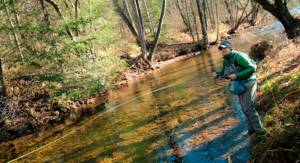
Various flies are used in the spring when fishing from the surface. This is exactly the period when nature begins to come to life and many insect larvae and insects themselves appear on the surface of the water. Flies are attached to thin hooks so that the fish is not too careful and the bait has a natural action. During this period, the use of fly fishing is justified.
There are other baits, but there is no point in focusing on them, since they are not very popular among anglers. They are able to attract trout or not, depending on the body of water in which the trout are found. For a “successful hunt” for trout, the list outlined in the article is sufficient.
Spinning trout fishing is also unpredictable and requires a series of experimental casts with different types of bait. As practice suggests, such bait as the “castmaster” shows good results when fishing for trout. When fishing for trout, this may be the most catchy spoon, although it can be successfully caught on “shakers” and rotating spoons. It is very important to choose the right lure both in size and color.
Trout can attack potential prey on the surface of the water, while it rises from a depth of up to 10 m. In such conditions, a “popper” will work great. For fishing in the water column, a “wobbler” is suitable, and you need to have several baits with different immersion depths. Well, of course, we shouldn’t forget about such a bait as the “castmaster”; the advantage of this spoon is that it has excellent flight characteristics, which allows you to cast it over a considerable distance.
The size of the bait is selected depending on the size of the fish that is found in a given reservoir. If the reservoir is paid, then trout can reach a weight of 3 kg or more. The same applies to large natural reservoirs, where trout can weigh 10 kg or more. As for small or mountain rivers, these can be specimens no more than 1 kg. Therefore, under such conditions, smaller baits are used.
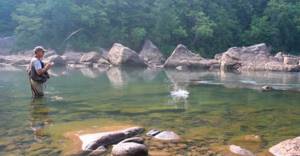
Very effective trout fishing using fly fishing , which involves the use of artificial flies. They don't fly off the hook, but they imitate natural insects very plausibly. Moreover, you need to be careful about which flies you should use. If this is a fly of a larva that has not yet flown out or has already flown out, although not so long ago, then this fact may alert the fish. Without any fear, she grabs those flies that imitate insects and larvae that are part of the trout’s diet at the moment. But here, too, there is a huge field for flight of fancy, since trout can peck on flies that have a unique appearance or on flies that were previously ignored by it.
Where to look for trout depending on the time of year
The activity of trout in the natural environment varies depending on the time of year, and fish will behave the same way when reared artificially. It is worth understanding that it will not be possible to fish in the same place in spring and summer on a paid platform.
Spring
Immediately after freezing, while the water has not yet warmed up very much, trout will actively scour the entire reservoir in search of food. It will definitely not stand in one place, even if the food supply in the water area is at the highest level. You will have to look for trout everywhere, depending on the gear used, it is better to fish the surface where the trout will go out to bask in the sun and catch insects that have fallen into the water.
When the temperature rises, trout go in search of food in shaded places ; they can stand under the branches of vegetation hanging over the water, in snags , behind boulders at the bottom of the reservoir.
Summer
This time of year is least suitable for trout fishing; warm water will make the predator minimally active . The fish can stand in a visible place, but at the same time not react at all to the bait offered to it.
Fishing for trout on paid platforms during this period will bring success in rainy weather and with a significant decrease in temperature during the daytime.
You need to look for it in holes, in places where water is supplied to the reservoir , special attention should be paid to areas with moderate currents.
Autumn
This period is considered the rainbow season, during which time you can catch a real trophy without much effort. Gear can be cast throughout the entire body of water, using any of the acceptable methods. Trout will quickly evaluate the offered baits and begin to respond to them almost instantly.
The best places during this period are considered to be rifts , edges , places near snags and stones at the bottom, places where water is supplied to the reservoir .
Winter
You can catch trout on a platform in winter, but for this you need to take into account only one thing: whether the pond freezes or not. From the ice, the same gear is used; in open and cold water, slightly different options are used.
The fishing location does not change; with a significant drop in water and air temperatures, the trout will go to the depressions and wait there for more suitable conditions. The fish will happily respond to almost all baits offered to it during this period.
When to catch trout

Trout can be caught throughout the year , with only the spawning season being an exception. Trout is a fish that prefers clean, cool water, so it can be found in mountain rivers that have particularly clean water. During the summer, when the water begins to warm up as the sun rises, trout go deeper and wait for the sun to set and the water to begin to cool again. Therefore, the best hours for trout fishing in the summer are evening, night and morning . Fishing for trout during the day is a waste of time unless the weather cooperates.
In spring it is better to catch trout in the afternoon, but in autumn it bites around the clock. It can only be caught in crystal clear water. If it becomes cloudy, the activity of this fish also decreases. Depending on the region, trout activity is especially pronounced during mayfly periods. As a rule, this is the end of May and the beginning of June. In the summer, trout activity decreases due to the heat, but in the fall its activity increases again and it is unlikely that you will be left without a catch.
Where and how to catch trout

Since trout loves clean and cool water, its main habitats are mountain rivers, mountain lakes, where only trout and, possibly, grayling are found, as well as in large lakes, where other species of fish are found along with this fish. This is a very cautious and timid fish, so it is advisable to catch it in complete silence. She may be frightened by a loud stranger's voice or the silhouette of a person. In this case, she will try to go to quieter places where such noises are absent.
When going fishing, you should stock up on camouflage clothing so as not to stand out against the background of nature. Trout stand with their heads upstream in places where the current is fastest and the water is coolest. Therefore, having determined the trout’s parking place, they approach it very carefully, and also against the current, so that it cannot see movements on the shore. In such places, as a rule, the water is more saturated with oxygen than in places where the current is not so fast. In addition, in areas of slow flow, the water warms up faster, so trout will always leave such places if the water temperature is above +20°C.
Small schools of small trout accumulate in areas of fast current or at the boundaries of fast and slow currents. If there are large boulders in these places, then she can certainly be behind them, gaining strength after a long struggle with the current. Larger individuals prefer deeper places where there are natural shelters, in the form of snags or fallen trees. It can be seen near steep banks and in places where there are changes in depth.
Trout can be found both in the water column and closer to the surface, where it collects various insects that have fallen into the water. Depending on weather conditions, it can be found almost at the very bottom.
In other words, her favorite places are where visual changes in the speed of the mountain river flow occur. Behind boulders in the area of bridges and various rapids, near waterfalls where water is saturated with oxygen, in river mouths, whirlpools, holes, as well as at great depths, where the water is always cool, in the area of various natural or artificial shelters where it can hide at any moment, sensing danger.
Where is the best place to fish?
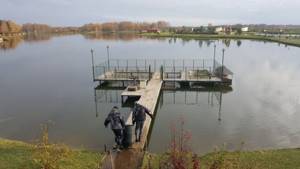
Before you catch trout on a paid pond, you should understand where the fish live. Most often it is located at great depths or near such a place. Everything will depend on weather conditions. If the fish has been in the lake for several years, then it will not stray far from its favorite places. Most often this is at depth.
If the fish were introduced not so long ago, the trout will move throughout the pond. Especially near different edges. Before you catch trout on a paid pond in the fall, you should find the location of the fish. It can be located either near the surface or almost at the bottom. Factors that influence the choice of fishing location:
- trout prefer to be in places where there is great depth;
- the fish will move along a certain route, most often near the edges;
- the predator tries not to stand still, but constantly swims to different horizons.
Situations often occur when fish swim to the surface. However, in most cases it swims closer to the bottom. All this depends on environmental conditions. Relying on them, the bait is also selected. Therefore, before deciding what to fish for trout with, it is worth studying the environmental conditions.
You should also pay attention to the water temperature. However, trout are unpredictable fish. Therefore, it is worth experimenting with the location and depth of fishing. It is worth remembering that trout on the platform loves depth and edges.
Bait for trout

Since trout is a more predatory fish, the bait should contain ingredients that have a natural fishy smell. It could be fishmeal, shrimp (smell) or squid smell. As with any other fish, the bait should be properly prepared so that it creates a food cloud in the water, actively attracting fish. To do this, you can use special purchased components (geysers) or add floating components to the bait. You can use pelets for trout. They can not only be used to feed fish, but also be used as bait. The trout's biting activity is greatly influenced by the color of the bait or groundbait. She prefers bright colors. For a greater attractive effect, bright dyes should be added to the bait.
Most anglers don’t even realize that trout can be baited to ensure effective fishing. If you have the opportunity to fish in one body of water, then you can use the following recommendations: to begin with, feed the trout every hour, and then increase the feeding process to once a day, and then to once a week. Thus, the fish will constantly visit the place of interest to it. In this case, you can always be with a catch. But this option is not suitable for a reservoir that is located at a considerable distance.
The Most Popular Lures and Lures for Trout Fishing
Let's create the So-Called Top - 5
Oscillating spinners (fly easily and dive perfectly) for fast retrieving when you need to actively use elements of the game with bait. Choose a large size and variegated colors. We recommend buying Daiwa Crusader or Forest Miu;
Rotators (Pivots) . This is a universal look. The main quality is stable play. It is better to purchase wide-petal products. You can add acid-colored flies. Try - Rublex Celta turbo;
Wobblers . The standard specimen is produced in the shape of a round fish. Stock up on sinking and floating structures. Wobblers are suitable for the technique of slow retrieve (for passive trout). It can also be held in one place in the water column (this trick will not work with silicone, for example). Our pick is the Zip Baits Rigge;
Silicone . For example, worms. Interesting bait. Technique: jerk wiring. Also, sports fishermen use a passive method that maximally imitates “floating food”;
Twisters, Nymphs and Crustaceans . Rubber lures. Twisters need to be carried out evenly; sometimes you can “play” with the rod. But the last two specimens are relevant for fishing when the fish is close to the surface of the water. They sink slowly and linger for a long time in the thickness.
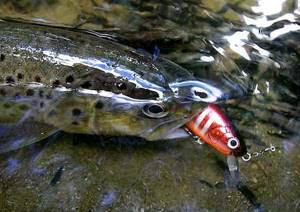
Video “Trout fishing with a spinning rod”
Trout fishing with spinning rod
Many spinning anglers are fond of trout fishing if it is found in nearby reservoirs. Such fishermen can very easily switch from catching one type of predator to another. Spinning can be considered a universal tackle, capable of catching any fish, even peaceful ones. It all depends on the angler’s level of imagination and ability to handle a spinning rod. Many spinning anglers use spinning rods for bottom fishing; they just need to change the configuration of the equipment.
Igor 06.12.2016

